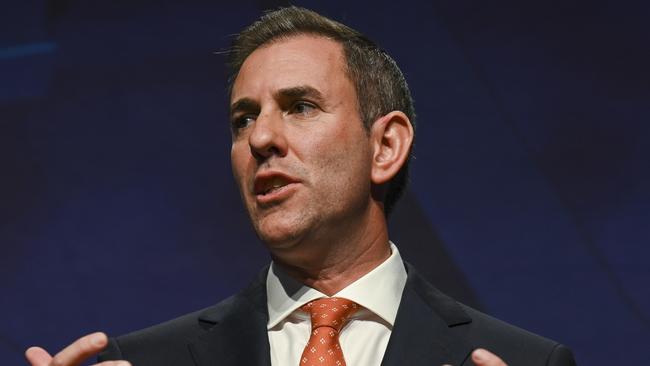Hoopla and spin can’t disguise the unflattering truth
Jim Chalmers’ so-called ‘turnaround’ is simply the result of gross errors in Treasury’s forecasting.

He undertook a number of initiatives such as the media lockup and selected drops to favoured journalists to ramp up the potential political gains of having almost exclusive media attention for an extended period, particularly during the budget week. Giving each budget a corny name became the norm.
The balance between media manipulation and serious fiscal management has now reached a point that every serious policy announcement is already known prior to the actual delivery of the budget. That hoary, perennial remark made by treasurers and finance ministers – “you’ll just have to wait until budget night” – should now be totally dismissed.
The fact that we even knew the budget bottom line – a surplus of $4bn – beforehand was extraordinary.
The real aim of this overload of pre-publicity is to ensure that those going into the lockup have a favourable impression of the budget and write up flattering commentary as a result. The fact that various interest groups have been made aware that their lobbying for more benefits/favours/concessions will be rewarded, at least in part, is also part of the strategy.
Let’s be clear on one matter – the supposed budget turnarounds. The Treasurer has claimed that this budget records “the greatest turnaround” ever. To be precise, this achievement, if you care to call it that, was actually made by the previous treasurer, Josh Frydenberg.
Compare Frydenberg’s final budget handed down in March 2022. There the budget deficit for this financial year was expected to be $78bn compared with a surplus of over $4bn. This makes Chalmers’ turnaround of $41bn pale into insignificance.
But here’s the thing: these budget turnarounds are overwhelmingly a reflection of the forecasting errors made by Treasury. They are not because the government has done the hard yards by cutting spending, culling ineffective programs and the like. It’s just that Treasury was unduly pessimistic and reality has caught up with its officials.
The bizarre practice of Treasury to bung in long-term average commodity prices, particularly when prices are at historical highs, within a short space of time meant huge forecasting errors on the revenue side, and hence on the budget bottom line. That Treasury has decided to model future commodity prices in a slightly different way in this budget comes as no surprise.
More recently, Treasury also failed to pick up the impact of a tight labour market (which it did forecast) on income tax revenue, particularly the effect of bracket creep. So rather than the announcement of “the biggest budget turnaround ever recorded”, it should really be “the largest forecasting error ever made by Treasury”.
When it comes to the budget itself, the key figure is the growth in total government spending. Forget all the details, the switching of spending priorities, the percentage of additional revenue spent and saved. Just look at the growth of spending. This tells you the likely impact on inflation and the chance that the Reserve Bank will have to compensate by further raising interest rates.
Next financial year, government spending is expected to increase by nearly 4 per cent, reaching $682bn. By the end of the forward estimates in 2026-27, government spending is expected to be $763bn. (It’s worth mentioning here that there is an assumption in these out-years that spending on the NDIS can be restrained, with the current annual rate of growth halved.)
This is the real story of the budget: government spending continues its relentless march, with no prospect whatsoever of a return to pre-pandemic proportions. Note there that in 2018-19, government payments as a proportion of GDP were 24.6 per cent. Under Chalmers’ hold of the Treasurer’s post, this is expected to be between 26.5 per cent and nearly 27 per cent.
The fact that the surplus is expected to be fleeting is also significant in the context of a budget that seeks to offset any inflationary pressures. Next year’s deficit is projected to come in at $14bn and be higher again in the next two years. This is the antithesis of budgeting for an inflationary environment.
In order to counter this criticism, a totally new economic concept has been invented by Chalmers, presumably in cahoots with senior Treasury officials – deflationary spending. Let’s be clear here: there is no such thing as deflationary spending. The idea that the configuration of a spending program can have a (short-term) downward effect on the measured headline CPI is true enough. But it’s irrelevant to the real inflationary impact.
For starters, the Reserve Bank has made it clear that it looks through these types of effects on the CPI – the introduction of the GST is the classic example. In any case, the RBA is driven by the trimmed mean of the CPI in its decision-making.
But Chalmers seems to think that manipulating the measurement of the CPI, which includes rebates (for electricity bills, for instance) will actually bring down core inflation. The key issue is that, by taking $500, say, off some people’s electricity bills, there is every chance that they will spend that sum on something else.
In similar fashion, by increasing the JobSeeker allowance and the Single Parent Payment, the recipients will spend a very high percentage of the additional money. In the context of tight economic conditions and unacceptably high inflation, this is a potential highway to locking in inflation at an unacceptably high rate.
This is notwithstanding Treasury’s heroic assumption that the increase in the CPI will fall from 6 per cent to 3.25 next financial year. It’s worth remembering the lesson of the 1980s: trying to compensate large numbers of people for cost-of-living pressures simply leads to the perpetuation of these pressures, possibly even their acceleration.
The one thing that might save the Albanese government the embarrassment of further increases in interest rates is the possibility that the economy falls in a hole. But the associated rise in unemployment is unlikely to be a popular outcome.








It’s not entirely clear when the budget became more of a marketing gimmick than a serious economic and financial statement. Certainly, Paul Keating, when he was the treasurer, saw the potential for the budget to be used for political purposes.